Abstract
Sera collected from Australian pelagic birds specifically inhibited the neuraminidase of the Asian/57 (H2N2) strain of human influenzavirus. Neuraminidase inhibition titres of some sera were high and the avidity of the inhibitor was comparable to that of specific antibody. The neuraminidase of A/Hong Kong/1/68 (H3N2), which has undergone considerable antigenic drift in man since 1957, was inhibited to a lesser extent by the bird sera, while the neuraminidases of the A/BEL/42 (H0N1) and A/FM/1/47 (H1N1) strains were not inhibited at all. The inhibitor could be removed from the sera by adsorption with A/57 virus particles, but not by particles of A/BEL or A/FM1 viruses. These results suggested that the inhibitor in the bird sera was specific antibody. The antibodies to A/57 neuraminidase were found in sera from wedge-tailed shearwaters (Puffinus pacificus) and noddy terns (Anous minutus) nesting on islands off the north-east coast of Australia. They were not found in sera from bridled terns (Sterna anaetheta) or brown gannets (Sula leucogaster) nesting on the same islands. Antibodies to A/57 neuraminidase were also detected in sera from short-tailed shearwaters (Puffinus tenuirostris), which migrate around the Pacific Ocean, suggesting that these birds may be responsible for bringing avian influenzaviruses from areas in the Northern Hemisphere into Australian coastal waters.
Full text
PDF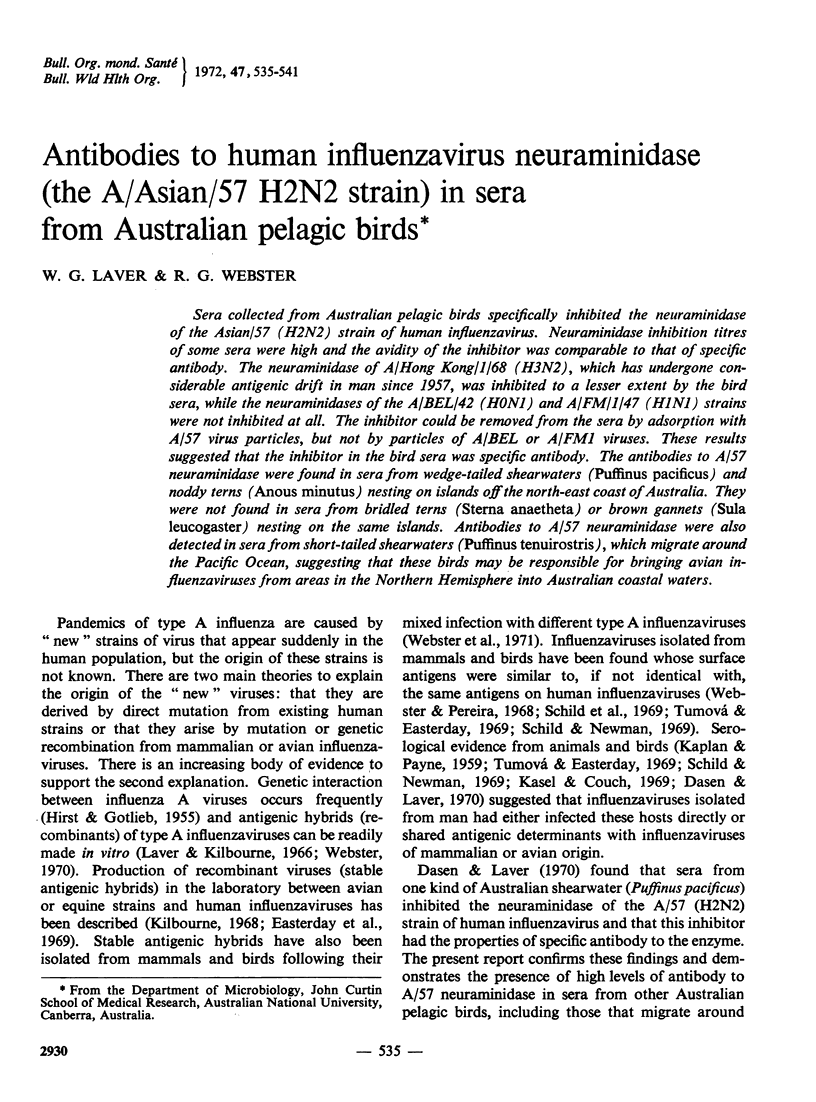
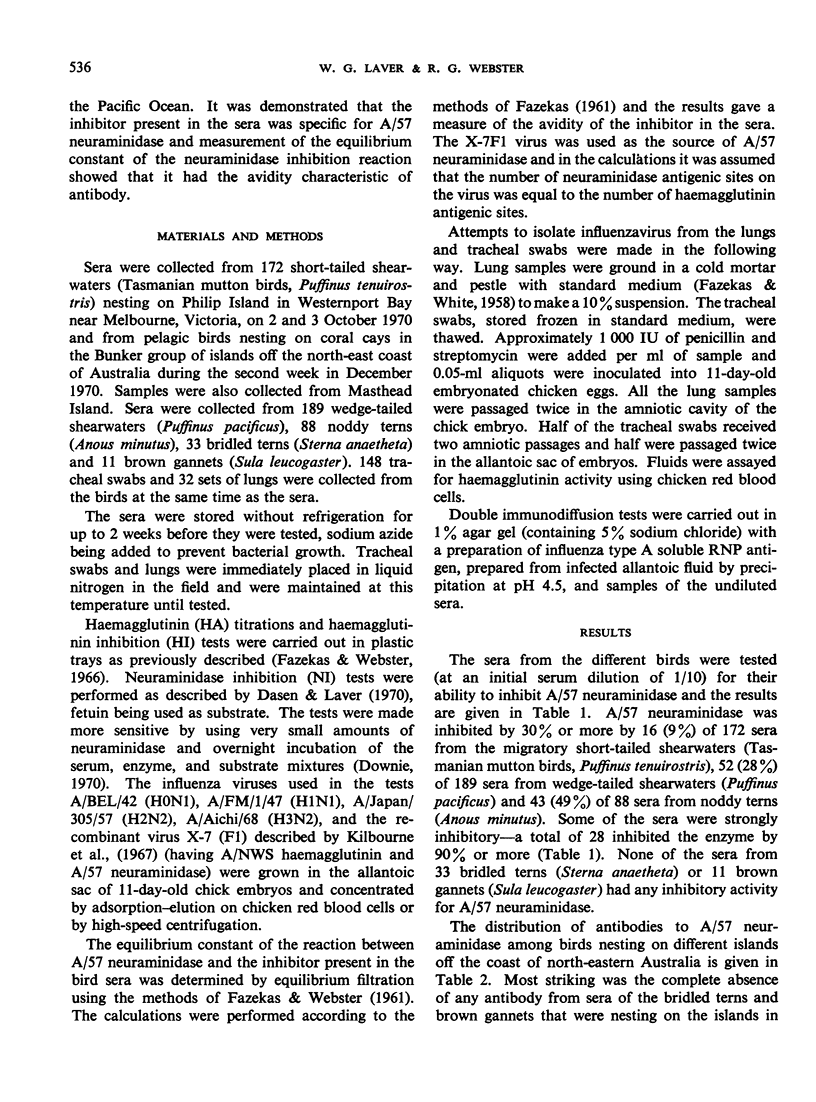
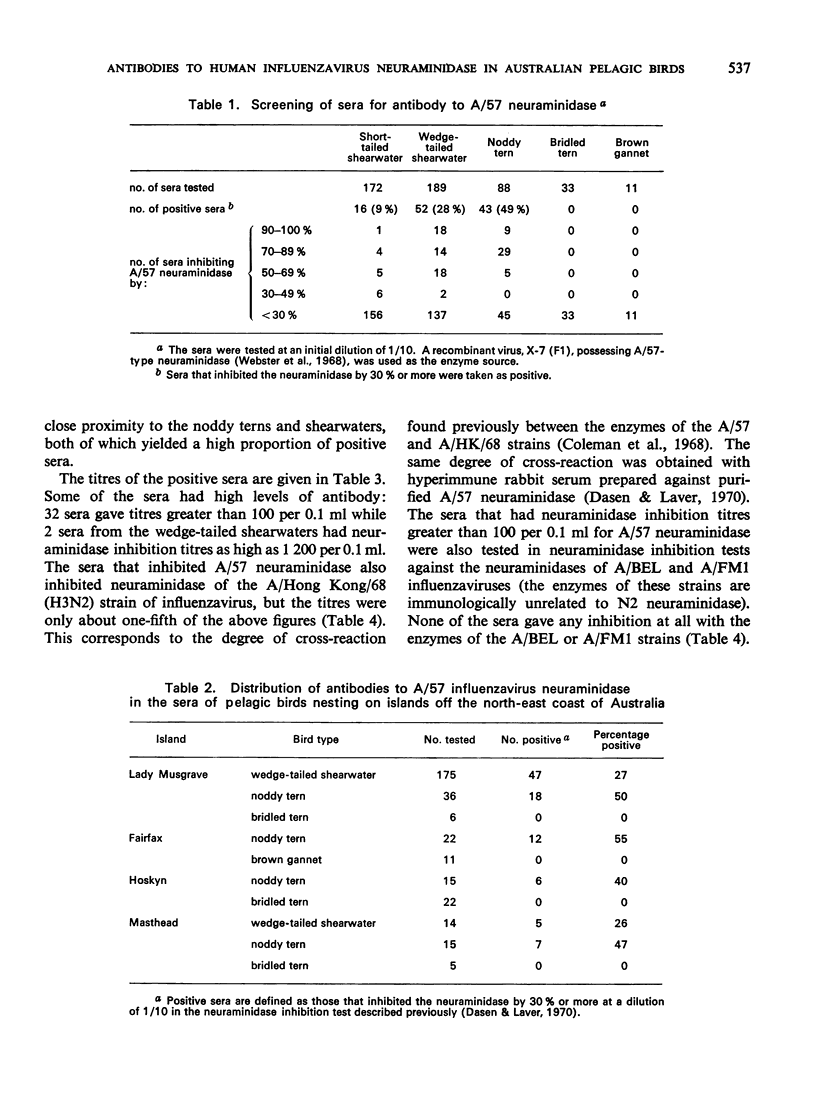
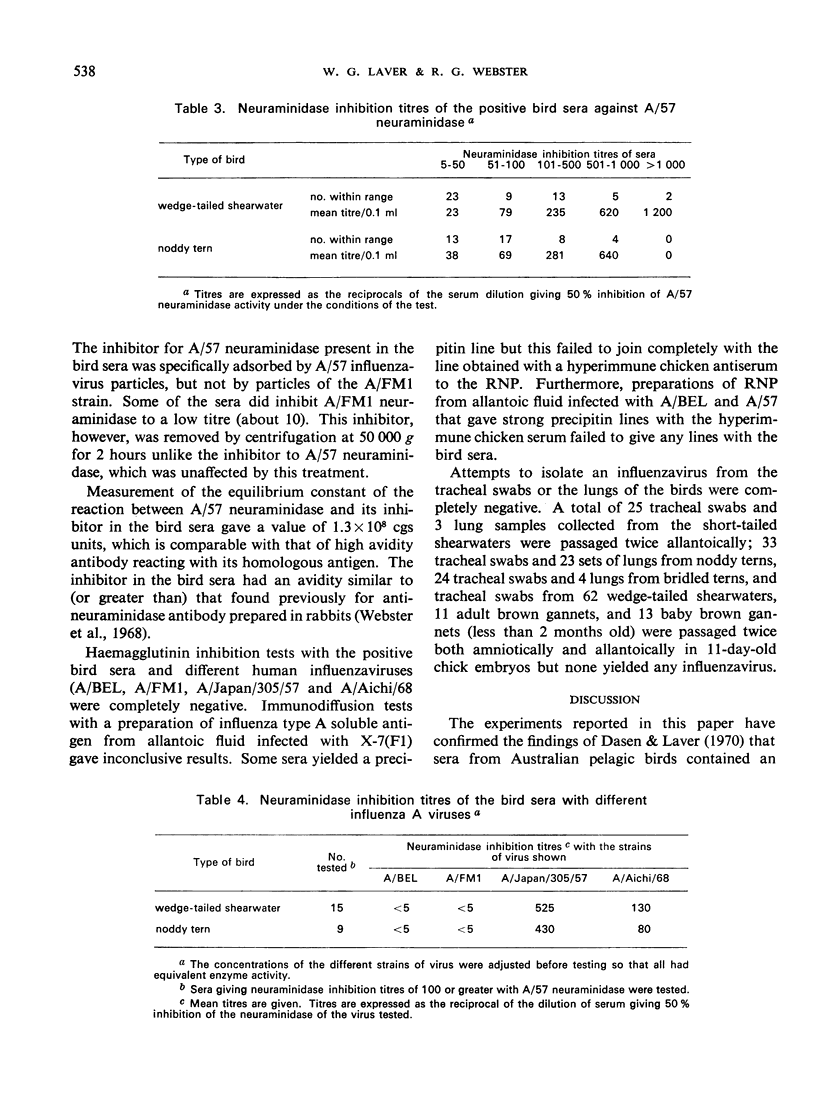
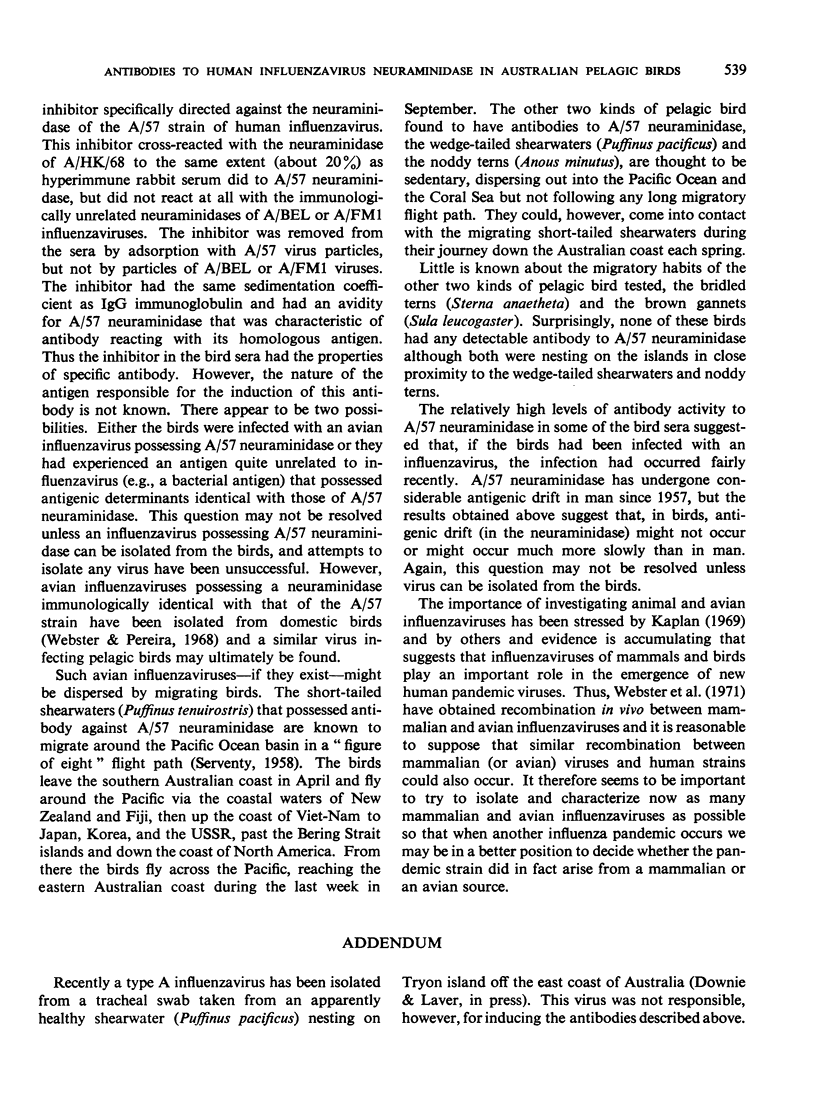
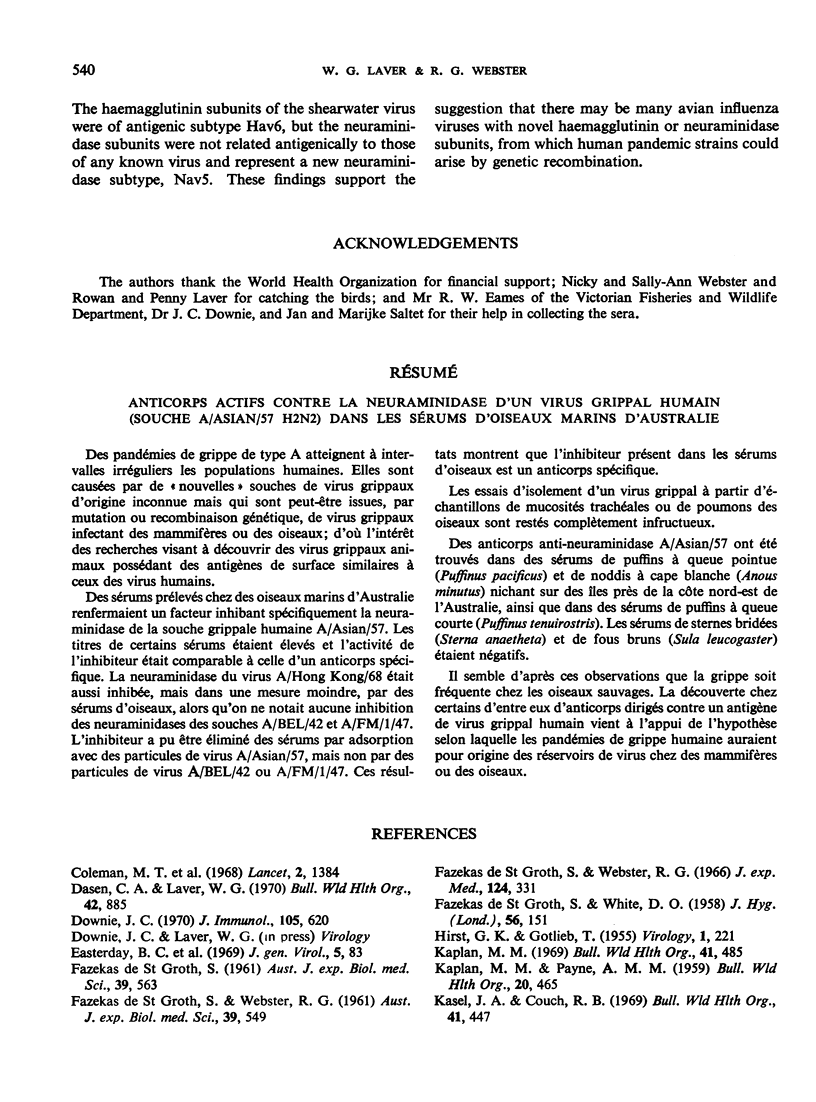
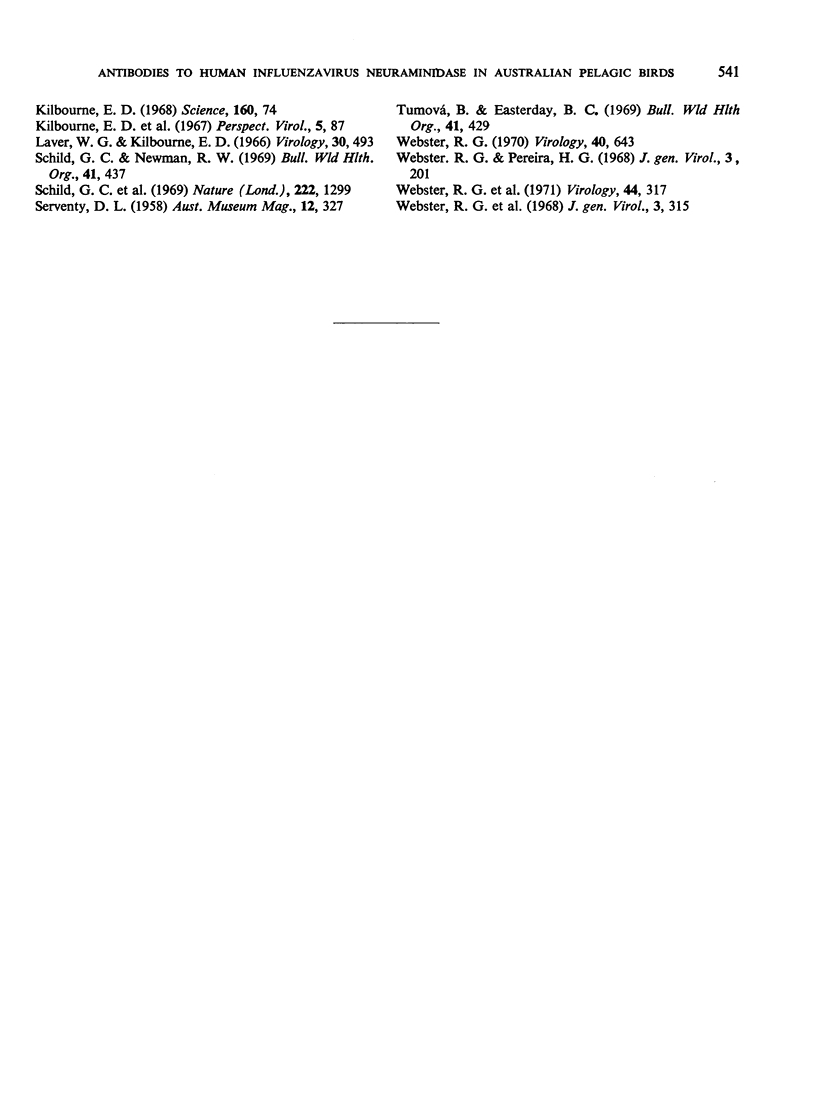
Selected References
These references are in PubMed. This may not be the complete list of references from this article.
- Coleman M. T., Dowdle W. R., Pereira H. G., Schild G. C., Chang W. K. The Hong Kong-68 influenza A2 variant. Lancet. 1968 Dec 28;2(7583):1384–1386. doi: 10.1016/s0140-6736(68)92683-4. [DOI] [PubMed] [Google Scholar]
- Dasen C. A., Laver W. G. Antibodies to influenza viruses (including the human A2-Asian-57 strain) in sera from Australian shearwaters (Puffinus pacificus). Bull World Health Organ. 1970;42(6):885–889. [PMC free article] [PubMed] [Google Scholar]
- Downie J. C. Neuraminidase- and hemagglutinin-inhibiting antibodies in serum and nasal secretions of volunteers immunized with attenuated and inactivated influenza B-Eng-13-65 virus vaccines. J Immunol. 1970 Sep;105(3):620–626. [PubMed] [Google Scholar]
- Easterday B., Laver W. G., Pereira H. G., Schild G. C. Antigenic composition of recombinant virus strains produced from human and avian influenza A viruses. J Gen Virol. 1969 Jul;5(1):83–91. doi: 10.1099/0022-1317-5-1-83. [DOI] [PubMed] [Google Scholar]
- FAZEKAS DE ST GROTH S., WHITE D. O. An improved assay for the infectivity of in influenza viruses. J Hyg (Lond) 1958 Mar;56(1):151–162. doi: 10.1017/s0022172400037621. [DOI] [PMC free article] [PubMed] [Google Scholar]
- Fazekas de St Groth, Webster R. G. Disquisitions of Original Antigenic Sin. I. Evidence in man. J Exp Med. 1966 Sep 1;124(3):331–345. doi: 10.1084/jem.124.3.331. [DOI] [PMC free article] [PubMed] [Google Scholar]
- HIRST G. K., GOTLIEB T. The experimental production of combination forms of virus. V. Alterations in the virulence of neurotropic influenza virus as a result of mixed infection. Virology. 1955 Jul;1(2):221–235. doi: 10.1016/0042-6822(55)90018-0. [DOI] [PubMed] [Google Scholar]
- KAPLAN M. M., PAYNE A. M. Serological survey in animals for type A influenza in relation to the 1957 pandemic. Bull World Health Organ. 1959;20(2-3):465–488. [PMC free article] [PubMed] [Google Scholar]
- Kasel J. A., Couch R. B. Experimental infection in man and horses with influenza A viruses. Bull World Health Organ. 1969;41(3):447–452. [PMC free article] [PubMed] [Google Scholar]
- Kolbourne E. D. Recombination of influenza A viruses of human and animal origin. Science. 1968 Apr 5;160(3823):74–76. doi: 10.1126/science.160.3823.74. [DOI] [PubMed] [Google Scholar]
- Laver W. G., Kilbourne E. D. Identification in a recombinant influenza virus of structural proteins derived from both parents. Virology. 1966 Nov;30(3):493–501. doi: 10.1016/0042-6822(66)90125-5. [DOI] [PubMed] [Google Scholar]
- Schild G. C., Newman R. W. Immunological relationships between the neuraminidases of human and animal influenza viruses. Bull World Health Organ. 1969;41(3):437–445. [PMC free article] [PubMed] [Google Scholar]
- Schild G. C., Pereira H. G., Schettler C. H. Neuraminidase in avin influenza A virus antigenically related to that of human A0 and A1 subtypes. Nature. 1969 Jun 28;222(5200):1299–1301. doi: 10.1038/2221299a0. [DOI] [PubMed] [Google Scholar]
- Tumova B., Easterday B. C. Relationship of envelope antigens of animal influenza viruses to human A2 influenza strains isolated in the years 1957-68. Bull World Health Organ. 1969;41(3):429–435. [PMC free article] [PubMed] [Google Scholar]
- Webster R. G., Campbell C. H., Granoff A. The "in vivo" production of "new" influenza A viruses. I. Genetic recombination between avian and mammalian influenza viruses. Virology. 1971 May;44(2):317–328. doi: 10.1016/0042-6822(71)90263-7. [DOI] [PubMed] [Google Scholar]
- Webster R. G. Estimation of the molecular weights of the polypeptide chains from the isolated hemagglutinin and neuraminidase subunits of influenza viruses. Virology. 1970 Mar;40(3):643–654. doi: 10.1016/0042-6822(70)90209-6. [DOI] [PubMed] [Google Scholar]
- Webster R. G., Laver W. G., Kilbourne E. D. Reactions of antibodies with surface antigens of influenza virus. J Gen Virol. 1968 Dec;3(3):315–326. doi: 10.1099/0022-1317-3-3-315. [DOI] [PubMed] [Google Scholar]
- Webster R. G., Pereira H. G. A common surface antigen in influenza viruses from human and avian sources. J Gen Virol. 1968 Sep;3(2):201–208. doi: 10.1099/0022-1317-3-2-201. [DOI] [PubMed] [Google Scholar]


